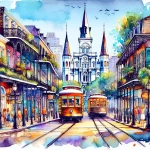New Orleans showcases a captivating blend of architectural styles, reflecting its rich cultural tapestry woven over centuries. The city’s architectural evolution has been influenced by major historical events, with neighborhoods like the French Quarter, Garden District, and Uptown exhibiting distinctive character and well-preserved historic structures.
In This Article
TL;DR
- New Orleans features a melting pot of architectural styles, including French Colonial, Spanish Colonial, Creole, Greek Revival, Italianate, Victorian, and Art Deco.
- The city’s architectural heritage mirrors its colonial roots, with influences from the French, Spanish, and Creole cultures.
- Iconic styles like the Creole Cottage, shotgun house, and grand antebellum mansions are quintessential to New Orleans‘ architectural identity.
Colonial Influences on New Orleans Architecture
The architectural landscape of New Orleans is deeply rooted in its colonial past. The French established the city in 1718, and their influence can be seen in the steeply pitched roofs, tall windows, and intricate ironwork of the French Colonial style. After the Spanish took control in 1763, they introduced elements such as thick walls, arcaded walkways, and elaborate plasterwork, characteristic of Spanish Colonial architecture.
The French Quarter, the oldest neighborhood in New Orleans, is a testament to the city’s colonial heritage. Many buildings in this historic district date back to the late 18th and early 19th centuries, featuring a blend of French and Spanish architectural elements.
The Birth and Evolution of the Creole Cottage
The Creole Cottage is a quintessential New Orleans architectural style that emerged in the late 18th century. These single-story homes are characterized by their rectangular shape, steeply pitched roof, and front-facing gable. They often feature a symmetrical façade with a central door flanked by full-length windows, and a front porch supported by thin columns.
Over time, the Creole Cottage evolved to adapt to the city’s climate and cultural influences, with variations like dormers for ventilation and Greek Revival or Italianate decorative elements. Today, Creole Cottages can be found throughout the French Quarter, Faubourg Marigny, and Bywater neighborhoods.
The Antebellum and Plantation Homes of New Orleans
The antebellum period saw the rise of grand plantation homes in New Orleans and the surrounding areas. These stately mansions, built by wealthy plantation owners and merchants, were designed in Greek Revival or Italianate styles, with features like columned porticos, symmetrical façades, and elaborate cornices.
Notable examples include the Nottoway Plantation House, the Longue Vue House and Gardens, and the Beauregard-Keyes House in the French Quarter.
Shotgun Houses: Form Meets Function
The shotgun house is a narrow, elongated residential style ubiquitous in New Orleans. These homes are typically one room wide and several rooms deep, with a straight-line layout from front to back. Shotgun houses were introduced in the early 19th century and quickly became popular among working-class families due to their affordability and efficient use of space.
Variations include the double shotgun (two mirror-image units sharing a central wall) and the camelback (with a second story added to the rear). Shotgun houses can be found in many historic neighborhoods, including the Bywater, Treme, and Mid-City.
The Victorian Influence: Detail and Ornamentation
The Victorian era brought a new level of architectural detail and ornamentation to New Orleans. Victorian-style homes in the city are known for their elaborate woodwork, decorative brackets, and colorful paint schemes.
One iconic example is the Steamboat Gothic style, featuring intricate gingerbread trim, steep gables, and asymmetrical façades inspired by the ornate design of steamboats. Other notable styles include the Italianate and Queen Anne, which can be seen along the historic streets of the Garden District and Uptown neighborhoods.
Art Deco and Modern Movements in New Orleans
In the early 20th century, New Orleans embraced more modern architectural styles like Art Deco and Modernism. Art Deco buildings are characterized by geometric shapes, zigzag patterns, and stylized ornamentation.
Prominent examples include the Charity Hospital building, the Lakefront Airport terminal with its stunning mosaic mural, and the New Orleans Public Service Building with its sleek, streamlined façade.
Preservation and Contemporary Challenges
New Orleans takes great pride in its architectural heritage, with organizations like the Preservation Resource Center dedicated to preserving and restoring historic buildings. However, the city faces challenges from climate change, hurricanes, and pressures of urban development that threaten its architectural legacy.
Balancing progress and modernization with preserving the city’s architectural character remains an ongoing challenge.
Architectural Tours and Cultural Engagement
One of the best ways to experience New Orleans’ architectural diversity is through guided tours offered by local organizations like the Preservation Resource Center and the New Orleans Architecture Foundation. Popular tours include the French Quarter Walking Tour, the Garden District Tour, and the Creole Cottage Tour.
Events like the annual New Orleans Architecture Week also provide opportunities to celebrate the city’s built environment and engage with its cultural heritage.






